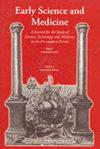混合物可以通过触摸识别吗?意大利文艺复兴时期医学对盖伦《论肤色》的接受
IF 0.5
2区 哲学
Q3 HISTORY & PHILOSOPHY OF SCIENCE
引用次数: 0
摘要
本文以盖伦的《肤色论》及其接受为线索,考察触觉在评估身体混合物中所起的作用。根据盖伦的说法,肤色是通过触摸病人的手掌皮肤来评估的,因为它“处于所有极端之间的精确中点”,因此混合良好。这篇文章考察了从中世纪晚期到现代早期,人们是如何接受这种关于触觉辨别能力的非凡主张的,并特别关注文艺复兴时期的思想。通过遵循盖伦的文本及其各种形式和用途,目的是阐明盖伦的“肤色”(complexio)概念的流动理解与文艺复兴医学中不断变化的触摸认识论有关,特别是通过揭示“物质”(substantia)的解剖学概念。本文章由计算机程序翻译,如有差异,请以英文原文为准。
Can Mixtures Be Identified by Touch? The Reception of Galen’s De complexionibus in Italian Renaissance Medicine
This article uses Galen’s De complexionibus and its reception as a thread to examine the part played by the sense of touch in the assessment of bodily mixtures. According to Galen, complexions were assessed by touching patients with the skin of the palm of the hand because it is “at the precise midpoint between all the extremes” and, thus, well-mixed. This article examines how this extraordinary claim about the discriminative power of touch was received from the late Middle Ages up to the early modern period, with a special focus on Renaissance thought. By following Galen’s text and its various forms and appropriations, the aim is to illuminate the fluid understanding of the Galenic notion of ‘complexion’ (complexio ) in relation to changing epistemologies of touch in Renaissance medicine, notably by shedding light on the anatomical concept of ‘substance’ (substantia ).
求助全文
通过发布文献求助,成功后即可免费获取论文全文。
去求助
来源期刊

Early Science and Medicine
HISTORY & PHILOSOPHY OF SCIENCE-
CiteScore
0.50
自引率
0.00%
发文量
22
审稿时长
>12 weeks
期刊介绍:
Early Science and Medicine (ESM) is a peer-reviewed international journal dedicated to the history of science, medicine and technology from the earliest times through to the end of the eighteenth century. The need to treat in a single journal all aspects of scientific activity and thought to the eighteenth century is due to two factors: to the continued importance of ancient sources throughout the Middle Ages and the early modern period, and to the comparably low degree of specialization and the high degree of disciplinary interdependence characterizing the period before the professionalization of science.
 求助内容:
求助内容: 应助结果提醒方式:
应助结果提醒方式:


